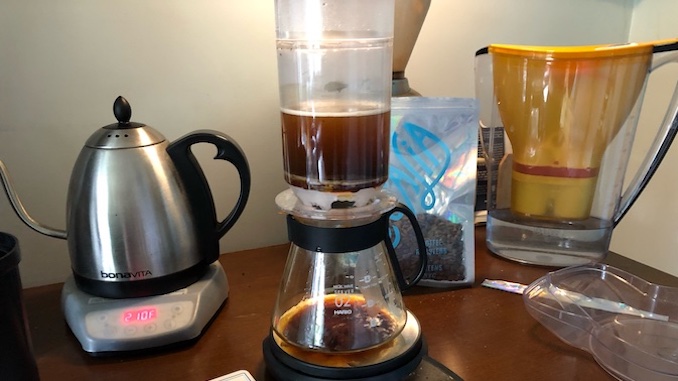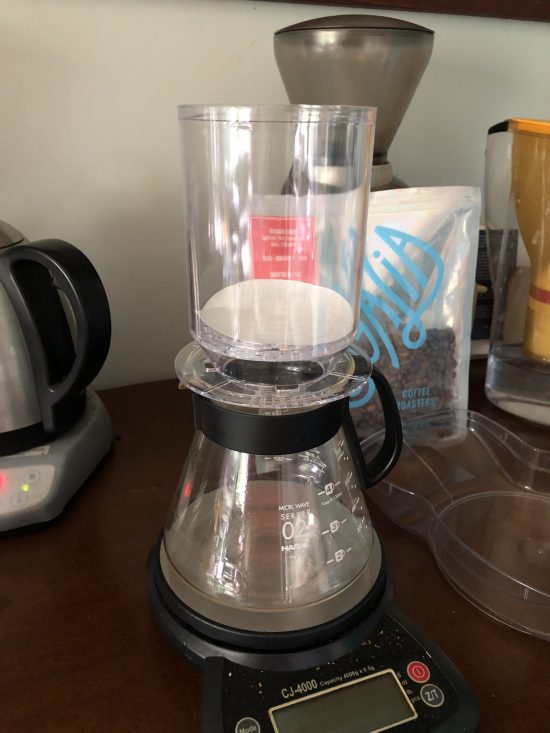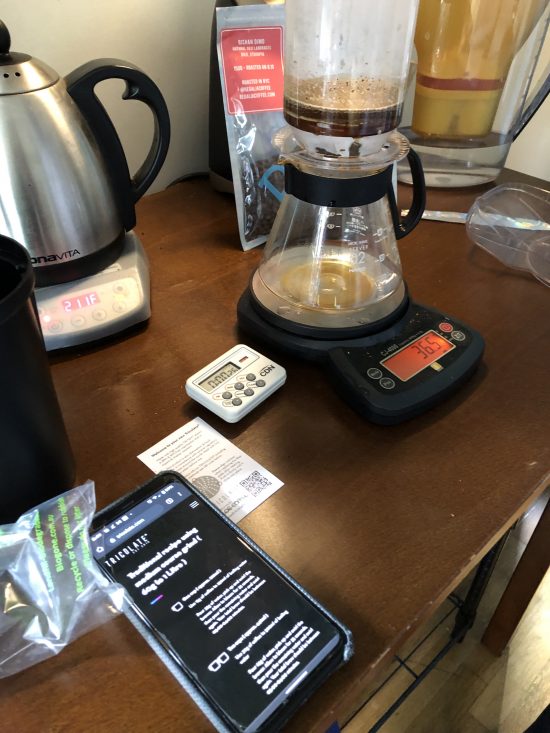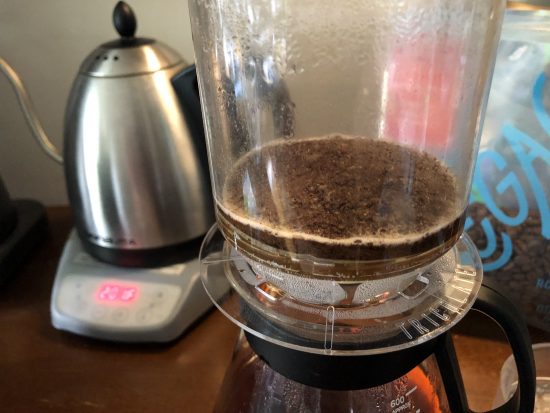
The Tricolate challenges the boundaries of high extraction with their home brewing device.
BY ANDREW HO
BARISTA MAGAZINE ONLINE
Photos courtesy of Andrew Ho
Ask 10 different coffee people about their preferred brewing device for making filter coffee these days, and you’ll likely receive 10 totally different answers.
Many new-age brewers feature their own unique design twists and innovations in the pursuit of better brewing, which prompts two questions: “What are the challenges in pourover brewing?” and “Which of these challenges can an improved brewer design overcome?”
For the folks behind the Tricolate, the main problem is obvious: uneven brewing, making for sub-optimally extracted coffees. In other words, it’s really hard to brew evenly, meaning you aren’t getting the most out of your coffee.

Getting High Extractions with Tricolate
By making even brewing simple and nearly foolproof, the Tricolate can promote some super high extractions. And we’re talking super high. There have been wild reports floating around on coffee forums of brews achieving 25% extraction yield and beyond while tasting not just good, but exceptional—something practically unheard of (for reference, an average pourover hovers around 18-20%). To be clear, the goal of the Tricolate isn’t necessarily crazy-high extractions. Rather, a coffee that’s brewed as evenly as possible will, as a result, be thoroughly extracted.
But the Tricolate does have one other trick up its sleeve that helps it achieve those mythical extractions: It’s the first pourover brewer that brews without bypass. But before we unpack what that means, let’s take a closer look at how exactly the Tricolate … trickles.
What Is the Tricolate?
The Tricolate claims to be the “most advanced filter brewer on the market,” and while it looks a little unassuming, its clear, high-walled, cylindrical brew chamber does look like something out of a laboratory.
The brewer consists of three parts: the brewing chamber and base, which are one piece; the removable brew bed upon which the filter paper sits; and the dispersion screen into which water is poured to be evenly and gently showered over the coffee grounds.
The entire Tricolate is also made of special Tritan plastic (the name “Tricolate” is presumably a portmanteau of “Tritan” and “percolate”), which makes it highly durable and aids in temperature stability during brewing.

How to Brew with It
Brewing with the Tricolate is easy and straightforward, and takes far less attention than, say, a V60. To set up, insert the brew bed and filter, add water to rinse, add coffee, lightly shake to settle, affix the dispersion screen, and you’re ready to start brewing.
Brewing consists of two phases: the bloom and the main brewing phase. With the Tricolate, pouring in pulses isn’t necessary nor advisable. After the initial bloom, simply add all of the brew water at once, and … that’s it! There’s also no need for a gooseneck kettle; any sort of kettle will do. It’s also recommended that you give the Tricolate a little swirl once after the bloom and again after adding the rest of the water to ensure the bed of grounds stays flat and level, allowing for the water to flow through the coffee evenly. I’ve found that it takes about 1:15 to add all of my brewing water, after which I can just leave the brewer unattended for a few minutes while it finishes dripping through.
From its wide, flat brew bed to its straight-walled brew chamber, to its precisely engineered shower screen, it’s clear that the Tricolate’s sole purpose is to maximize even extraction; it’s honestly difficult to imagine another brewer that would perform better in this regard.
Bypass-Free Brewing
And then there’s the matter of bypass-free brewing. With every other brewer that brews using a paper filter, there will inevitably be some water that percolates through just the filter and skips the coffee bed entirely—i.e., the “bypass water.” This is water that doesn’t contribute to the brewing and extracting of the coffee.
With the Tricolate’s cylindrical design, there is no bypass—all of the brewing water has to flow through all of the coffee, which, by design, will easily result in high extraction yields. The lack of bypass also means that brews will take significantly longer, usually anywhere from five all the way up to 10 (!) minutes.
Who Should Use the Tricolate?
So do I think the Tricolate is the perfect coffee brewer for everyone? Not necessarily, but the answer to that question ultimately depends on what your goals and needs are when it comes to making a pourover.
After getting used to brewing with the Tricolate, I have certainly produced some remarkable cups of coffee. But from just a pure taste standpoint, when compared side-by-side to a V60 brew of the same coffee, the difference can be striking. It’s like relistening to a favorite song for the first time on a pair of really nice headphones—everything just comes alive. Once dialed in, coffees brewed on the Tricolate have been sweeter, fuller, and brighter.
What I found most intriguing was the Tricolate’s “super high extraction” recipe. It utilizes a fine grind and a 22:1 ratio of water to coffee, which sounds absurd. The resulting brewed coffee was just as bewildering. It was … good. It was really good. It tasted delicate, sweet, and floral, with hardly any astringency or bitterness. To be fair, it did border on being too light to my taste, but I certainly wouldn’t complain if I was served this at a café, nor would I suspect that it was brewed at such a high ratio.

What to Look Out For
While the Tricolate can produce some standout cups of coffee, there are a few things to be aware of before picking one up. Firstly, there’s the price tag. At $70 USD, I certainly wouldn’t consider it an entry-level brewer. The filter papers also aren’t cheap, at anywhere between $16-$25 per 100-count pack, depending on which distributor you order from (the filter papers are also unique to Tricolate, so they’re not as widely available either).
The Tricolate is also clearly suited to brewing lightly roasted coffees. I would even hesitate to brew any coffees approaching medium, more developed roasts—otherwise you risk overwhelming your cup with roasty and ashy flavors.
Additionally, there are a few user-experience shortcomings that are worth noting. My first complaint is that it can be quite annoying to properly seat both the brewing bed and the paper filter. I eventually got the hang of it, but the first few times were pretty frustrating. Cleaning up also isn’t the best experience.
Final Thoughts
While I genuinely appreciated what the Tricolate has to offer, I still find myself reaching for my trusty ol’ V60 to start most of my mornings.
The Tricolate might not also be the best fit for high-volume cafés where speed and efficiency take priority; most customers can hardly wait three or four minutes for their pourover, so five to 10 is probably out of the question.
But for the café looking to truly showcase the best coffees they have to offer, or the home brewing enthusiast wanting to get the most out of their brewing setups, the Tricolate could be the brewer you’ve been waiting for.
ABOUT THE AUTHOR
Andrew Ho (he/him) is a coffee professional based in Portland, Ore. He enjoys cooking, endearing animal videos, and a juicy pourover on a daily basis.

